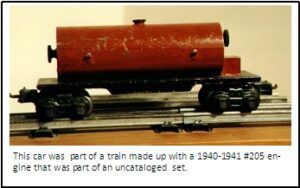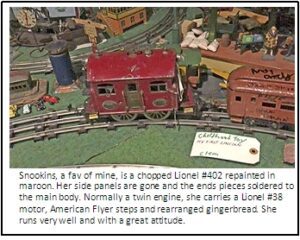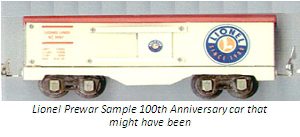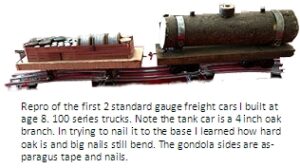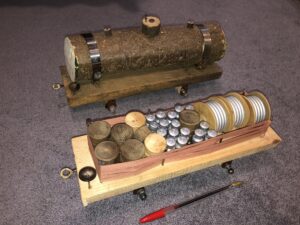Homemade Trains and Me, Part 4: Why Were Home Made Trains Built (Additional sources of parts *STANDARD GAUGE TRAIN BUILDERS.)
By Clem Clement, Past TCA President TCA# 64-987 Spring e*Train 2023
To my knowledge only Jim Waterman is building Standard gauge trains at this time. And most are custom trains that have not been built before; or if so, not available. *If you lived along the railroad tracks, there was always something interesting rolling by or parked on the siding.
To model. Buttons made good hand wheels, wooden match sticks make window frames. To this day if a see a small-mechanical-thingie that’s on the way to metal recycle, I grab any bolts, screws and other usable parts. One of my recent acquisitions is quite unique. It’s two toasters bolted together and Standard gauge wheels attached. I have added toast, soaked in clear Lacquer paint with imbedded nails for strength. I’m hearing that the mechanism from the giraffe car will properly pop up the toast. A guy from Jersey has an entire kitchen train Flat iron for the loco, toaster, hot plate that glows red and other neato cars. (I’m so jealous…) The toaster car gets great use at the WGHT events. **Did I mention picking up metal found along the rails? Mostly good for engine weights and gondola loads.
Rail spikes worked well for weights. In later years, I was involved with a train museum. A fellow brought in a bucket of railroad “fall off “ parts. They sold nicely @ $1.00 each. *I remember using old rusty door hook eyes and hooks for The Packard used a logo with a trim line in the shape of the Packard radiator. It did not indicate Packard and was not the Packard shape. It was V-etches and those tools were used by several car manufacturers. I made several of the correct sets for Packard. Experts like “King of Jacks” were also very helpful. *I have friends who advertised in local towns around the Lionel factory, searching trains the workers had bought/swiped from the factory.
I saw a collection of Mickey Mouse hand cars that the worker had liberated. *A smarter‐than‐me IVES guy checked early eBay using IVES transition piece nomenclature. Such as IVES #1842. I slept thru that good idea. *I have a friend who was detained in a hospital for 6 months. He founds a collection of old train magazines from the 50’s and wrote everyone who had trains for sale back then. He did well with the toys/trains/parts he received. *Overseas shopping: Has great potential. Lionel/Marx sold well in England. Marx had different livery than that offered stateside. Hornby sold well all over the world. For a Time period, Hornby made only a few colors of their common steamer and painted up tenders of many country’s colors. A buddy found a full box of various tender’s livery. Years ago, there was a story about a Jack‐in ‐the‐Box somewhere that turned up in a rare color and different box. I don’t know if it was true or not? In a German train store, I found a Lionel wind‐up set I did not know they produced.
*UPGRADE PIECE. (Wood over electric loco to make diesel‐shape loco). I have seen three‐standards gauge IVES pieces with a modernized wooden/medal cab over the motor. Little Johnny wanted a diesel loco for his prewar standard gauge trains and nobody made one right after the war. So, daddy took Grampa’s standard gauge IVES engine and swapped over a homemade diesel‐looking cover and “Johnnie” was happy. Both my pieces were built over low‐ mileage motors. Recently I saw a third such built, but the $ got too high. *Most anything can work (wooden clothes pin‐flat car stakes)
*GIFT FOR SOMEONE (Gramps to Grandson; wanna build a steam engine?)
*MIND SPARKED BY SOMETHING. Many is the time that I walked thru a flea market with an open mind and saw a piece/part that had potential. Golf cart wheels, skate wheels and bearings and erector set parts come to mind. 8 couplers. Actually, I still have a jar full that I use for a homemade train that wandered in with no couplings. (These days toy train repair parts are hard to find with MTH breaking up(?) and the world changing. I never did figure out how to use the spring and mechanism from a wooden rod on a pull‐down shade. *One day an old victrola washed up on the sandy beach. I drug it home, thrilled. The thing was full of sand and the small cabinet ruined. I dried it and lubed it. It was to be the deck and motor for a round house turn table. It kicked around for years as I studied the how and whys of a turntable build. One day the scrap man got it… Oh, I had a huge container of match book covers. NO matches) The same thing happened to it. (On trash day, I had to guard my treasure files)
*Usually, I had to paint over cigar‐box wood as I could not remove the glued‐on advertising paper. *In my old car hobby, I’m building back a ’39 Ford pickup. I’m doing a proper job while trying to save some $$. I noticed that hose camps are a judge‐able item and need to be proper for the make and model of car. So cheapo me sez: “In my wanderings, let’s see if I can find correct original hose clamps, put them thru the parts tumble treatment, paint them silver which is very near the original cadmium treatment of the original.” I have a bucket full of correct clamps and my truck looks good. You’d be surprised how many complements on the clamps!
*Auctions: Now days auctions are a good possibility for a great find. First, you don’t HAVE to [be] at the auction! Let me tell you a story about my efforts at Ted Maurer’s auctions. For many years, he conducted auctions from September until June and sometimes in the summer as well. Many of us patrons knew each other so, this was a great social event as well. Many a Saturday, Chaplain James Warrington and I would roll from Northern VA around o‐dark:30 am to hit the famous Ridge Restaurant before 8:00 am. The farmers were there, having finished their rounds. Eggs and potatoes were $3 and gravy on scrapple was aplenty (I hope you all know the wonderful story about their cow and the school on the hill nearby…) Then a couple of miles to the fire hall for the auction. We think Ted helped the fire hall expand their building with a bigger hall. Ted also had command of some of the basement space. A customer left several glass cabinets and fancy shelves for the room as well for open and closed train auction displays.
I got lucky on a train from the lockable display, it was a great day. I remember Ted wearing a particularly UUUUgly Tie one time, so I challenged him to an ugly‐Tie contest. My Tie has never ever been beat in a contest. Just think about a yellow egg yolk surrounded by purple mist… It came from the wild Tie store on Market Street in Phila for $0.99 cents. To add to the niceness factor, the bottom triangle had been dipped in a gravy bowl some time along the way. Both of my sons have won with that Tie! (Fear not, the champ is retired to the closet moths.) Over the years I found that I could buy dirty and tired standard gauge, do a CLEM‐fab‐ cleaning dance, replace parts as needed and squeak a small profit. The goal was to spend a $K, clean, repair and sell $500 worth at the next York, save $5k worth of train into my collection, and have a couple of hundred back in the bank. I used the three York rule. If the piece survived 3 Yorks or other shows, like the Nor Temple in Delaware, it went back to Maurer. Ted used to say, we sell Clem’s trains twice.
At an auction down Maine onetime, me and my bud drives half a day to get there. There is an IVES standard gauge steamer set in an empty box. Next to and with a different auction number are train parts, some IVES parts and the box was sectional. The parts box was first. I was a nervous wreck trying to find out what was in the parts box, without me giving away my need and desire for both boxes… I had my bud already to buy the parts so nobody would figure what I wanted. Seemed like forever, when the auctioneer finally took a look at the piles and casually stated “aaaah let’s sell this junk in one lot.” I could have kissed him. (In after‐ action thinking, we think the set box top was there as well with books or some such in it. Years later I got correct set box.) I was thrilled and still have the set. My bud was not used to that kind of $$ floating around. Then he sees 9 another bidder bid $3408957095709347.67 for a Chippendale chair and he needs our help and a bungee strap to tie the chair to his Harley…
*At TCA York, I used to have several customers for big sheet metal parts. Car bodies, roofs, frames, rust. That tub was always an attraction. I painfully remember the meet Tom Sage brought 3 huge boxes of parts. I asked if he if he was getting out of the business. He said no, but with reproes coming out he was switching over to focus on old toys and therefore dumping his parts collection.
*Back to my tale: Ted would organize the auction such that the last 20 lots or so were rust grabbers. The crowd would be packing out, and only a few were there with their number cards held up high. Someone would bid $5 and I’m in for a 10er. Maybe one more hit and I have the rust special of the day. Home it went. The trucks. wheels and other plated parts hit the Thumbler’s tumbler that evening or the next night. Wheels and trucks were oven or sun dried. Sometime I used the same tumbler to polish the wheels with rouge‐covered walnut shells. Eventually I used non‐homogeneous metal parts like broken bolts, screws etc. The 4‐ hour tumble rotating run and the part got was enough to recover the lust and appearance of a non‐rusted wheel. (Since the wheels and axles of many 200, 500, 400, 10 and 100 series trucks went in together, I learned that many trucks were shimmed‐to‐gauge at the factory.) I have never seen write ‐ups about truck‐gauging by Lionel. I also learned what trucks were painted, dipped or metal‐dyed.
*One time, Ted had the center cab of a Lionel #402 and some other Tin in a tray. By dumb luck or great skill, I noticed a modified motor and other parts under the table as they were heavy, I laid low and the piles came my way. Let’s see if I can describe the loc now called “SNOOKINS” (you all know that custom trains and custom cars have to have a name.) That’s the rules. It had a Lionel #38 frame and motor and American Flyer brass steps. This is cab only with the ends mounted directly to the cab. Kinda like a cute little electric yard switcher. *Over the years of collecting home‐made trains, I found many of the pieces had been bought at flea markets and junk sales solely for their commercially‐made wheel and trucks. Once removed the homemade body was disposed of (to me, hopefully.) Thus, I was always in the hunt for wheels and trucks. I found a stunning homemade standard gauge freight car on O gauge trucks. It came out of my repair cycle as a standard gauge piece. (It also had a child’s‐pouchof coins as a load, which still is inside; on the way to the market.)
*My bestest dive into a junk box got me a Mohave‐ painted Lionel #42 with no motors and a coupler bracket missing. She is in sight of me here as a I type today. Yes, of course, I bought the entire box. *We have found that car shows, with flea markets included, are a fine hunting grounds for parts. Old trains that don’t function any more seemed to be demoted to the garage/barn. When the property sold there is usually a farm/house sale. Golly that is fun. Mixed in sometimes I have struck gold. You know, toys and Tin figures are sometimes mixed is with train accessories. I have hit signals, buildings and the such that a way. Berlin, NJ has a permanent flea market. Dealers run the yard sales hotly on Saturday and offer their prizes on Sunday. At one farm auction near Medford, I watched a pile build up @ .50 a bid. Turns out the buyer had a .50 cent bid on everything to help the auctioneer broom clean out the property…
*We find the simplest parts work: Cheese boxes made a great gondola. Upside down screw‐capped beer can and a few supports and you have a great water tower. Why were small towns called Jerk‐water towns? Every few miles a steam loco run low of water. A water tower is built near the tracks to fill the tender water tank. To get the water, a trainman climbs on the waiting loco and tender, jerks down the fill ‐arm and the water flows by gravity into the tender. All good…oops we need a person to live nearby to “Jerk the water” So, if there is a gate at the road at that point, we need a gateman as well. Pretty soon there is a post office, grocery store and bar: Aha! another jerk water town is born. How does the water get into the water tower?? The simplest is a pipe from a stream nearby that can carry the water downhill to the tank. Rain also works, as do gas/electric pumps. Ever swim in one? My late Uncle Raeman had the town water tower in behind his shop. One winter it froze and fell over.
*JUNK YARDS. I knew most of the junk yards in my area in my day. Quickly learned that most were in a teletype net with other yards. So, when I needed an overdrive for my 1954 Merc Monterey convertible, some junkie a few miles away had one. And off we went. The “ Pony” ran between the yards once a week, but we never could wait. That overdrive worked the rest of the time. I had that sweet car. I miss that car and the chicks who followed along. I drive through my senior year in college and through‐out my flying school days. And yes, I found trains in the junk yards as a well as car parts. *Did I tell yas about us saving a Junkie’s life?
It was early in a summer Saturday morning and already hot and sticky. Gears, my best bud and I were at Jessies place before 8 am. He usually was a round chatting, but not that time. We always were first in and took our tool buckets and headed out to the newly‐arrived section. Not Jessie. At the far end of a row was a huge turtle‐shaped ‘51 Merc Fordor (Heavy lead sled). We heard slight yell/moan and followed the noise to find Jessie flat under the car entrapped by an unconnected front spring. Jesse knew better, but safety first and go carefully were never spoken. Traditional at that time jacks were left everywhere in the yards, and you just grabbed one near your target piece and jacked the thing up. If the jack failed, you scooted out from under and grabbed another jack. This jack failed and caught his arm at the shoulder and trapped him flat on his back, face up. We grabbed another jack and worked the pile up enough to drag him out by his heels. We dusted him off and repositioned his old hat and off he went. Somehow from that gesture on, the prices he charged always seemed kinda low. Ole Jessie was like an alternate‐father to all us kids fixing transportation/hot rods. Later, we junked out a ’47 Pont. Jessie directed we drive it over thar, but 15 feet away from the desired spot there was an engine explosion and ball of smoke and she died and kneeled down. Jessie was rolling around in the dirt laughing that “You boys got everything out that car that it had to give.” (We got 18 dollars for the junker.)
A few months later only one fender had been removed. The next trip, it had a date with a mobile crusher. The first week back home from 23 ½ years in the service, I went to see if Jessie was still at it. They said he had recently moved to Florida and was relaxing. A new‐to‐ me group of gearheads were flogging old cars back to life. I tried to buy the business. I thought it would be fun junking old cars and having the parts to build and resell some for profit. (This needed special paperwork as in Jersey you could not unjunk a car’s records.)
*When I could visit my Chicken Farmer Uncle, I always l checked on his farm metal. Every farmer had a pile/ section/spot where misc. farm metal collected. Parts of plow shares, tractor parts, stuff found from previous farm owners (including a revolutionary cannon ball.) Usually there were some dead vehicles to be picked over as well. *Gallon paint/oil cans cut apart made fine freight car bodies. (Ya might want to empty them first.)
*Yard sales were a big deal during hard Times. I inherited 1/2 of Grammy’s large assortment of “Blue Dishes.” My cousin got the other half. For years I thought they were part of a large set. Not so. Grammy always had egg money to buy a blue dish or more likely the lid from a broken serving bowl. My cousin and I decided to put the 2 parcels back together, but many companies manufactured “Blue Dishes” so many pieces still were not complete and lids still go container less.
*We collected heavy metal parts on our countryside walks. They were gathered and sold to Soldo Brothers scrap yard just south of town. I don’t remember if we could shop there as well. I think not. *Bailing wire was always around. Good for securing car‐loads. Screen door hooks made fine couplers. Hook eyes made the female part. Seems like they were used in furniture stores that had a junk section. Road side flotsam and jetsam were always on my search list. Muffler/tailpipe brackets, truck body parts, chains/ tools always required a stop and inspection by me. Right size bolts/washers, tools came my way. To this day some, of my tools still display road rash.
*Uncle Raeman had an auto repair business and Uncle Tom has a chicken farm, “I learnt what I knowed from them two alternate‐ fathers.” Uncle Raeman left school around third grade I think, to start a 11 bicycle business. In 1923 he went to auto mechanic’s trade school in Phila. I have his homemade tool box that rides in my 1939 green Ford pickup to this day. He owned and ran Borden’s Garage in Mickleton, NJ all his life. He had one helper, Hoppy, to do gas pumping and help a bit around the place.
I have written about the wonderful things he did for his town and families. The town wrote to the Draft board that he was the only garage in town and all the farmers counted on him for farm equipment repair. He also fixed home heaters and most anything broken. My aunt was the lady of the town and most sweet unless you tried to outdo Aunt Elizabeth at the local flower show or even tried to make lemon Butter ½ as good as hers… One time I was in his shop and a farmer called that a plow shaft had broken off. I went with Uncle Raeman to the farm, out in the field to the broken plow, we welded it back together, he charged the farmer $0.50 cents and we went back to the shop. I questioned why not charge at least what the acetylene cost? He answered that the town had saved him from combat and he owed them his life. Proud I am!
*William Penn supposedly set foot on Phila soil there when he and his lady arrived from England {I’m related to her}. A cruise line left from there, crossed the Delaware River, then on to River View Park, Wilmington, DE and back. The boat brought under‐privileged kids to a park next to where Frankie Heiss lives, as a free summer day trip. The boat picked the kids up on the way back. Occasionally, kids would toss deck rockers off the boat. At one time, all our front porch furniture was dark green wicker ware from the river. The river was always helpful to my parts chase: boards, nails, containers, etc.) {Funny, Sandy lived along and swam in Big Muddy in Plaquemines Parrish, well south of New Orleans, and I swam in the big river near to us: The Delaware, the “smellaware” to us as it was so stinky from Petro‐ pollution. After every trip on the river, we had an oil ring on the Grumman canoe to scrub off.
*What is the difference between handmade trains and Modern Era Standard Gaugers? Not much. I understand from train histories that 10 minutes after the first trains rolled out of the station, kids were marking blocks of wood with train silhouettes and sliding the together around in front of their hearths. We all love the sound of steel‐on‐steel and the songs of an engine at work. Most cases the homemade trains are one of one. MESGers make a few of each style and get tired of that and go back to the thrill of creating something else of a different model of train. Size seems to be of no matter. Big or little, rolling medal is a thrill for all of us trainiacs. Yo’all join in,

